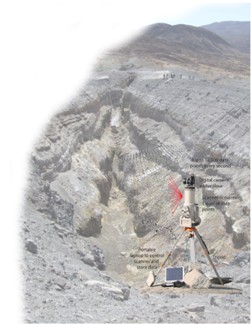
A 3D laser scanner provides the opportunity to create true 'virtual' outcrops. By firing millions of laser-points towards the real outcrop, the scanner is able to record the position of the objects in front of it. In essence, it captures a 3D photograph, from which we can build high resolution geological models at a variety of scales. The scanner creates a 'point cloud' - a collection of millions of points defining the 3D environment <fig 2>, and then uses digital images taken using a conventional camera, specifically calibrated for the scanner, to colour the point cloud, ultimately generating a virtual 3D picture at millimetre resolution.
Journey to Afar
Arriving in the hottest place on Earth is no mean feat. A three-day camel ride from the mountains of the Ethiopian Plateau to a barren desert some 100m below sea level marks just the first leg of the journey. There, in the Danakil Depression, lie some of the most extensive salt flats on Earth, a precious commodity that has been mined and traded for thousands of years. With camels loaded with over 80kg of scanning equipment, we then headed off in search of the main geological highlights of this expedition.
Our first target was the Dabbahu fissure, a steaming gap in the Earth’s crust. We would then set our sights on the final goal, the ascent and then descent into Erta Ale, one the oldest and most active lava lakes in the world.
The Dabbahu fissure is a gaping wound in the Earth created virtually overnight in September 2005 by rifting and a volcanic eruption. As we approached the edge of the fissure we were presented with a sight straight from a Hollywood movie. The scale was unimaginable, and you really felt that the Earth could just tear itself apart. We managed three scans around the fissure’s edge before being beaten back by noxious gases.